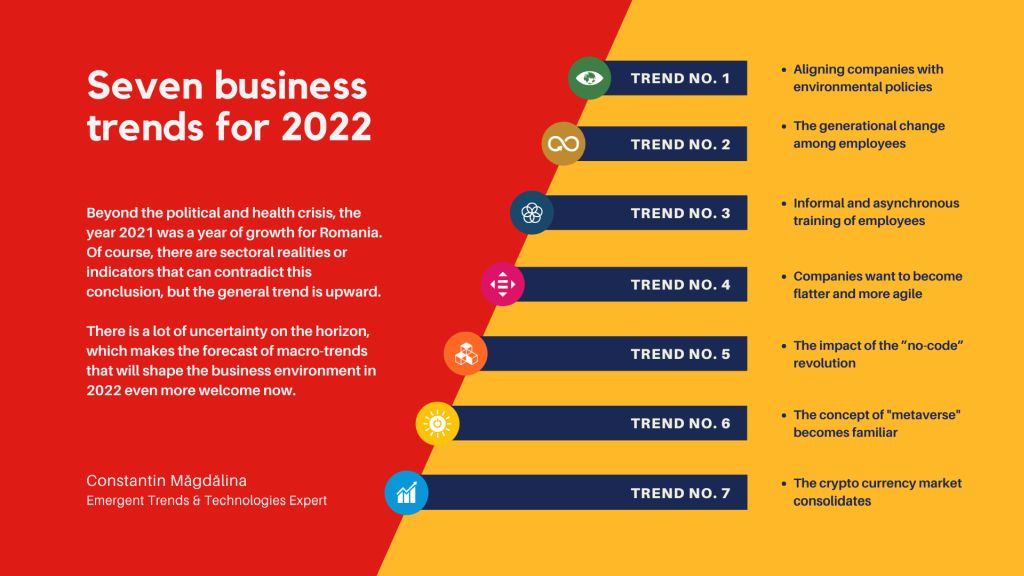
The end of the year is the time for balance sheets and evaluations of any kind. The decision makers of the companies look at their micro-operating environment and make plans for the coming year based on macro-forecasts. Beyond the political and health crisis, the year 2021 was a year of growth for Romania. Of course, there are sectoral realities or indicators that can contradict this conclusion, but the general trend is upward. There is a lot of uncertainty on the horizon, which makes the forecast of macro-trends that will shape the business environment in 2022, as well as the decisions of company leaders, all the more welcome now. So the macro trends that are emerging right now are the following:
1. Aligning companies with environmental protection policies
The government's commitments under the European Green Pact to reduce carbon emissions by at least 55% by 2030 will involve concrete legislation to oblige companies to comply with certain operating standards. The implementation of these measures will have an impact at all levels of the value chains, contributing to the creation of sustainable, local and well-paid jobs.
2. The generational change among employees
The ways of working continue to evolve. The main transforming factor is given by the pandemic and the need to work from home, which in these conditions, is increasingly consolidating as the norm. A second factor is the entry into the labor market of a new generation that is reluctant to work in physical presence on schedule. Thirdly, it is expected that employers will no longer offer open-ended employment contracts, but offers for project collaboration. According to the study Valoria , Trends and Challenges in Remote Recruitment in Romania , 40% of companies are open to increasing the number of remote roles, and just as many are prepared to accommodate the recruitment processes for remote work.
3. Informal and asynchronous training of employees
The labor market is plagued by numerous cases of resignation, reorientation or even burnout due to the challenges of the pandemic. Facing all these challenges requires a constant effort to ensure the well-being of employees, their adaptation to constant changes and the new dynamics of the way of working. In this context, companies are increasingly offering selected live training sessions, focusing more than ever on providing easily accessible on-demand online training sessions to complement employee integration and continuing development programs. In addition, advanced companies provide employees with the login credentials they need to access training content at their own pace, in their own terms.
4. Companies want to become flatter and more agile
Hierarchical companies and rigid structures tend to become vestiges of the past as the leaders of the new generation recognize the need for a flatter and more agile structure. This approach, which has been verified and validated in the IT field, is rapidly spreading to more and more industries. Agile approach means fast cycles of planning, product / service development, testing, implementation and feedback that help companies to respond quickly to change and stay relevant. It is also a partial response to the changing nature of work, especially to the proliferation of independent and distance contractractors (gig economy). It anticipates an era of flat organizational structures, which are detached from the model of traditional companies and look more like flexible communities.
5. The impact of the ”no-code” revolution
The democratization of data and technology has given rise to an entire industry that puts the skills and tools needed for technology-driven innovation in the hands of as much of society as possible, regardless of user expertise or experience. Cloud solutions for storage, networking, and processing are costly, and the risks of setting up an expensive infrastructure to try new ideas are greatly mitigated. Codeless interfaces will become more popular because a lack of programming knowledge or an understanding of statistics and data structures will cease to be a barrier to achieving a world-changing idea.
6. The concept of "metaverse" becomes familiar
What is a metaverse? It is a digital world that exists in parallel with the physical world we live in. Inside a metaverse, like the one proposed by Facebook, we will do activities that we are used to doing in the real world: to work, to play and to socialize. As the rate of digitization increases, these metaverses will shape and simulate the real world with increasing accuracy, allowing us to have more engaging, compelling, and ultimately valuable experiences in the digital realm.
7. The crypto currency market consolidates
There is an increase in the adoption of crypto currency payment systems in a wide range of businesses: PayPal has launched a payment product that allows customers to pay with crypto to all 29 million merchants that accept PayPal; Twitter has launched a "Tips" feature that supports crypto payments, allowing users to connect to CashApp, Patreon or Venmo and receive crypto tips; Visa and MasterCard have introduced crypto services and crypto payments to their customers. As more and more companies accept crypto currencies as a form of payment, digital rewards programs are the next step, providing a unique opportunity to meet the demand of the Z generation of flexible payments and digital transactions.
As the business environment becomes more complex, leaders are challenged to rethink everything from technology integration, payment methods, and the no-code revolution to employee involvement, remote work and agility as a way of working. By knowing these seven trends, leaders can meet the demands of a rapidly changing environment with customer-centric strategies that combine data and technology with the human factor. By doing so, they will likely be more prepared to capitalize on the benefits of technology, deepen employee relationships, connect with customers, and stimulate the growth of their companies.
About Constantin Magdalina
Constantin Magdalina has 10 years of working experience, while he performed in multinationals both in Romania and abroad. Constantin has a master’s degree in Marketing and Business Communication from the Academy of Economic Studies Bucharest. He is certified in Lean Six Sigma and ITIL which provide him a good understanding of processes and transformations within organizations. The Chartered Institute of Marketing certification furthered complemented his expertise and knowledge in business. In those over 4 years of working activity in a Big4 company, he initiated and conducted studies that analyzed different aspects related to the business environment in Romania such as the economic growth predictions of companies in 2013-2016, knowledge management, the buying experience in the age of digital consumers, social media 2013-2015, the utilization of mobile devices in Romania. He is the author of numerous articles on topics related to innovation, the efficiency of business processes, social media, the consumers’ buying experience in the age of digital, trends, and emergent technologies. He is invited as a speaker at numerous events and business conferences.





























